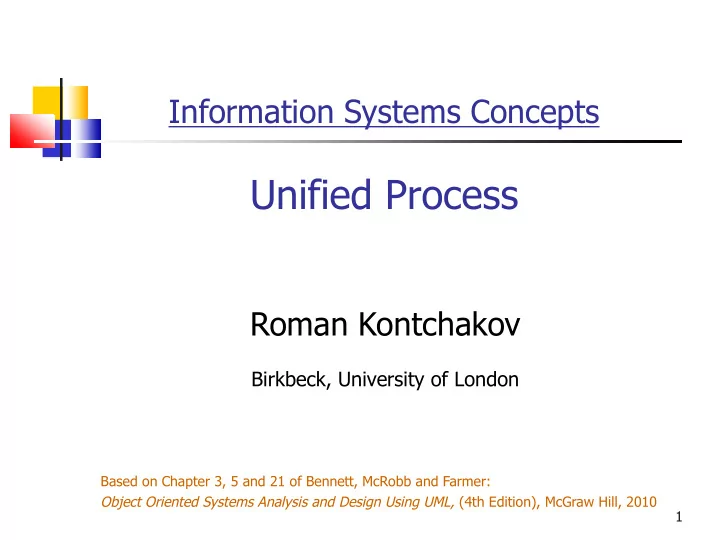

Information Systems Concepts Unified Process Roman Kontchakov Birkbeck, University of London Based on Chapter 3, 5 and 21 of Bennett, McRobb and Farmer: Object Oriented Systems Analysis and Design Using UML, (4th Edition), McGraw Hill, 2010 1
Outline n RUP / USDP n Section 3.4.1 (pp. 77 – 79) n Section 5.4 (pp. 128 – 135) n Section 21.3 (pp. 614 – 618) 2
Unified Process n Unified Software Development Process (USDP) n A public domain development methodology originally proposed by the same team ( in Rational Software, 1999 ) who created UML n brought the Booch method , OMT and Objectory together n Large and complex n significant learning curve involved, or tailor to fit n Rational Unified Process (RUP) n Proprietary methodology owned by IBM (since 2003) n The most mature OO methodology to date n USDP has been largely superseded by RUP (though they are very similar in their main aspects) 3
Underlying Principles n Iterative n Incremental n Requirements (use case) driven n Component based n Architecture centric n Visual modelling techniques 4
UP is Use-Case Driven A use case is a single interaction between user and system. 5
Phases n Phases are organized along time Each phase consists of a number of iterations n Inception Phase n Determining the scope and purpose of the project n Elaboration Phase n Capturing the requirements n Determining the structure of the system n Construction Phase n Building the system n Transition Phase n Product installation and roll-out 6
Milestones n Phases matter to project managers n Phases are sequential and delineated by milestones n Manager’s focus shifts from one phase to the next Each milestone is a decision point – begin next phase or stop now? 7
Workflows n Workflows are organized along content n Each workflow consists of a group of activities n 5 main workflows Requirements Analysis Design Implementation Test n Workflows matter to developers 8
Main Activities n Requirements capture and modelling (use case model, requirements list, prototypes) n Requirements analysis (identify objects, communication diagrams) n System design (system architecture) n Class design (sequence and state diagrams, design class diagrams) n Interface design (interface specification, prototypes) n Data management design (database specification) n Construction n Testing n Implementation (installation)
Phases and Workflows Transi sition Ince ception El Elaboration Const struct ction 3 1 2 4 5 6 7 8 Project Phases Re Requir irements Analysi ysis Iterations within each phase Desi sign Size of square relative to the Im Implementa tati tion time spent on a workflow Test st Workflows
Phases v Workflows n Within each phase, activities iterate. n No set rule for the number of iterations. n Workflows within a phase are the same. n The balance of effort spent in each workflow varies from phase to phase n All phases run from requirements to testing, but emphasis changes. n At first, main effort is on capture, modeling, analysis of requirements. n Later phases emphasise implementation and testing. 11
UP v TLC or 2D v 1D n In a TLC project the phases and the workflows and activities are linked Requir Re irements Desi sign Test st Analysi ysis Implementa Im tati tion together n For example, in the Requirements Requir Re irements phase only Requirements workflow Analysi ysis activities are carried out; all Requirements work should be completed before work starts on Desi sign Analysis . n In a Unified Process project the phases Im Implementa tati tion and the workflows/activities are Test st independent with each other n For example, some Requirements work may be happening alongside Analysis Another view of TLC work. 12
Take Home Messages Take Home Messages n Unified Process n Phases and Workflows n 2D Structure 13
Recommend
More recommend